IPC-7711/7721 Training And Certification
The IPC-7711/7721 training is a practical training and is often referred to as the soldering training, which is not entirely correct. The training is based on the IPC-7711/7721 document and contains the procedures to be used for reworking, repair and modification of assembled printed circuit boards (the end products).
It is a document where after a short introduction it is theoretically discussed how to handle the document and in particular attention is paid to practice. In practice, people are taught how to replace components correctly, components that are defective and components that are incorrectly assembled. They are taught this through a demonstration, after which they put it into practice themselves.
In IPC-7711/7721 training, they are also taught how to perform repairs to printed circuit boards, rail repairs, island repairs etc. that can occur in practice. Moreover, they are taught how to make modifications or changes to circuits with the aid of so-called wire bridges, modification wire and all that is done in practice.
The trainer explains what the intention is and shows how that should be done and afterwards the student gets to work with the required tools and equipment to practice this himself.
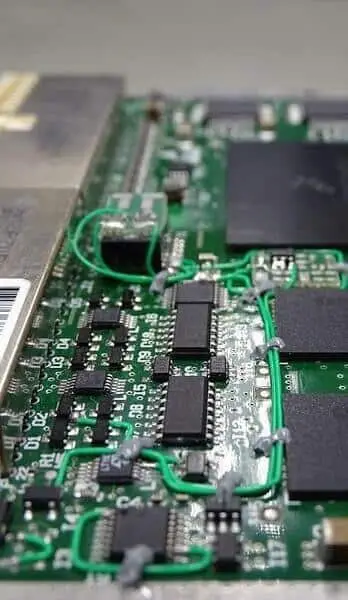
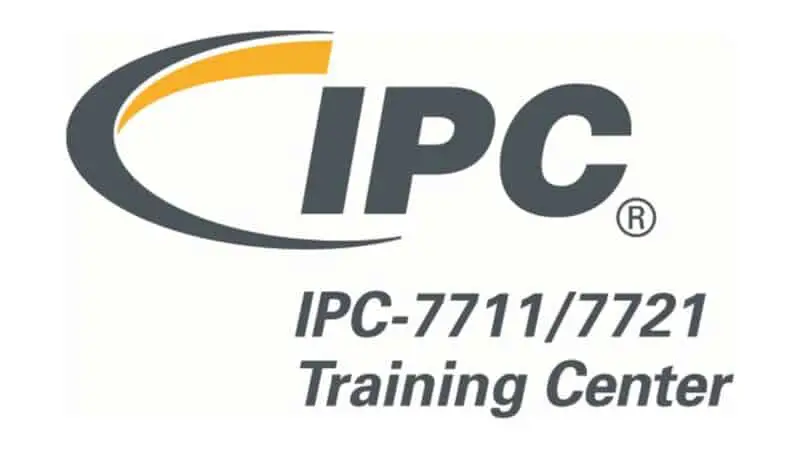
The Training and certification is suitable for following target group:
IPC-7711/7721 training is especially important for people who work in the repair department. The word repair is not entirely in place here, but is often used in that sense. Employees who work in production, products that do not meet the requirements, where solder connections are not in order because there is too little solder, or because components are placed incorrectly or because incorrect components have been placed and must be improved through a so-called rework process.
This is interesting for people who have to do repairs at the printed circuit board level, so attention is paid to this as well. But also for people who work in companies who have to repair PCBs or replace PCBs.
PB REPAIR, REWORK AND MODIFICATION OF ASSEMBLED PRINT CIRCUIT BOARD.
IPC-7711/7721 is interesting for employees of different companies
The nature of the training means that it is used by different companies, especially in production companies where after an inspection it has been established that the product does not meet the requirements because the solder connections are not in order. After this, the production process is improved by means of a rework process by the rework department within these production companies that assemble electronics.
But also companies that produce printed circuit boards use IPC-7711/7721 training to train their people to properly repair PCBs and tracks and the like. Repair companies that carry out repairs on request, products that have become defective and have been returned by a customer that must be repaired and made functional.
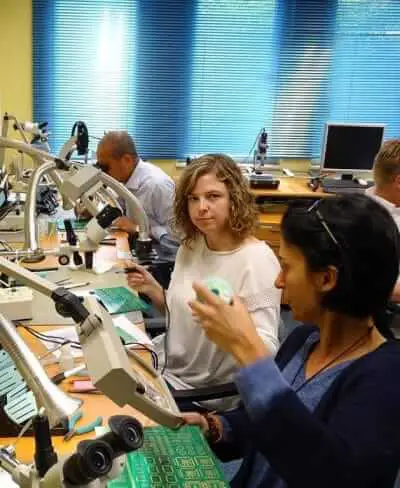
PIEK: Your knowledge provider for the Electronics Industry
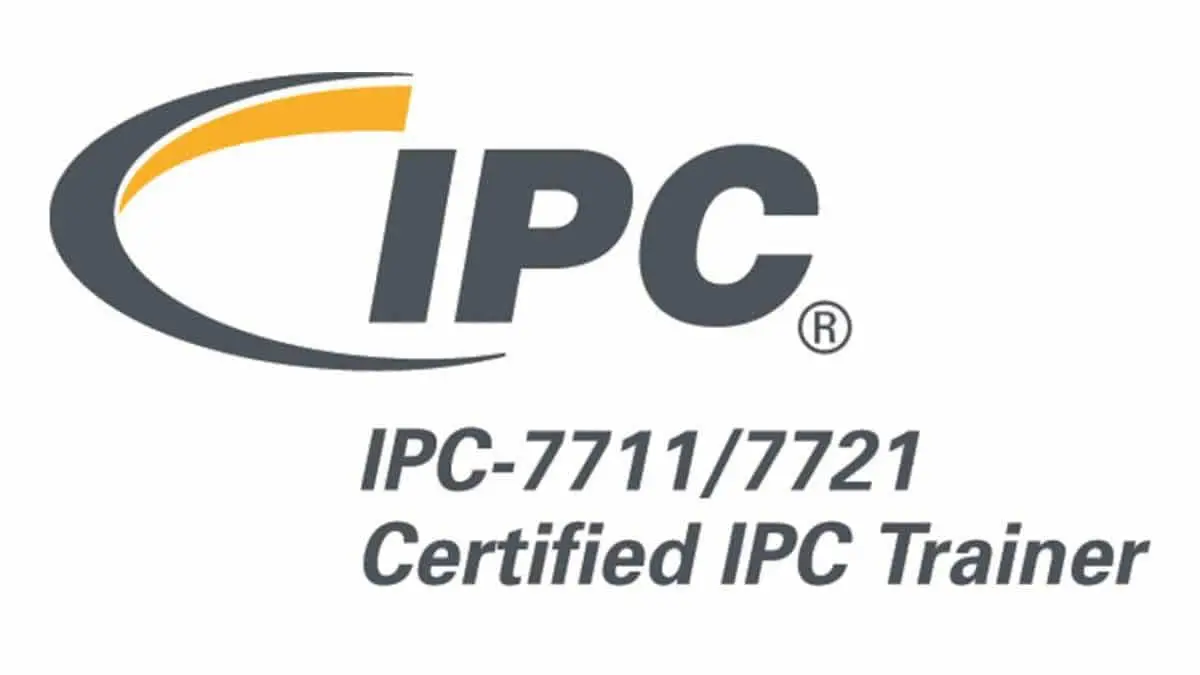
Application of the Training certification within companies
If you have followed IPC-7711/7721 training, you have learned in theory and especially in practice how to perform rework operations correctly, how to perform repairs to printed circuit boards and how to make modifications (changes of circuits).
With the certificate you obtain, you can also prove that you also master that in practice. It is interesting for companies because this way they can prove to customers that the employees who perform the actions are certified and know what they should do and how they should do it. It is a guarantee of the quality of the repair by people who are capable of performing certain actions.
The added value of the IPC-7711/7721 Training certification
The added value of the IPC-7711/7721 training for a company lies in, among other things, the fact that products that initially do not meet the requirements during an inspection, can still be made to meet the requirements by replacing components by soldering connections by performing such rework operations. Products that you would otherwise have to throw away, can still be repaired in this way so that they fully meet the requirements and can be sent to customers.
You will lose some money because of the rework of your employees, but you will eventually be able to sell your products again. Repair companies that have this type of training carried out live on the fact that they can repair and sell products again. They earn their money this way.
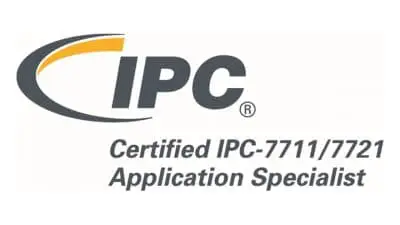
Validity of certification
If you have not previously been certified for the IPC-7711/7721 or your certificate has expired, you will need the initial IPC-7711/7721 certification.
This has a validity of 2 years. You must recertify within 6 months before the certificate expires. You have the following options for recertification:
- IPC-7711/7721 Recertification: full training for recertification
- IPC-7711/7721 Challenge Test: only the exam
- IPC-7711/7721 Refreshment of the Standard + Challenge Test
Variant of certification
IPC-7711/7721 CIS (Certified IPC Specialist)
This IPC-7711/7721 Certified IPC Specialist (CIS) variant is intended for operators
IPC-7711/7721 CIT (Certified IPC Trainer)
This IPC-7711/7721 Certified IPC Trainer (CIT) variant is intended for anyone who wants to train operators to CIS themselves
IPC-7711/7721 CSE (Certified Standards Expert)
This IPC-7711/7721 Certified Standard Expert (CSE) variant is intended for anyone who wants to become an expert in the field of the relevant standard. These experts are often used by companies as coordinators to correctly apply the standard within the company.
Upcoming regional IPC-7711/7721 training courses
| Start date | Training | Language | Location | |
|---|---|---|---|---|
| 28 October 2025 | IPC-7711/7721 | German | Amberg | Quote Request |
| 04 November 2025 | IPC-7711/7721 | German | Münster | Quote Request |
| 04 November 2025 | IPC-7711/7721 | German | Bretten | Quote Request |
| 11 November 2025 | IPC-7711/7721 | English | Heerlen | Quote Request |
| 18 November 2025 | IPC-7711/7721 | Dutch | Heerlen | Quote Request |
| 25 November 2025 | IPC-7711/7721 | German | Berlin | Quote Request |
| 25 November 2025 | IPC-7711/7721 | German | Singen | Quote Request |
| 09 December 2025 | IPC-7711/7721 | German | Michelstadt | Quote Request |
Frequently Asked Questions
The best way is to prevent the soldering iron tip from oxidizing! This means that after every soldering operation you clean your soldering tip (dry / wet) and then tin it before you put the soldering iron back in the tool holder. If it happens that the soldering iron tip is oxidized, you can clean it with a “tip activator” and / or sanding block / brass brush. All this is discussed in the practice part of the IPC-7711/7721 training.
In the 7721 part of the IPC-7711/7721 it is described how you can repair a conductor/track. For example with a wire, or with a repair kit (frame with or without adhesive). How this is done is trained in the practical module “conductor repair” of the IPC-7711/7721 training.
The IPC-7711/7721 training is both a theory but above all a practical training. In the theory module, mainly Chapter 1 of the book is discussed. In practice, the participants learn how to solder wires together (splicing), how to solder and desolder THT components and how to solder and desolder SMD components. Also modifications (jumper wires) to all types of components (both THT and SMT). Each participant has his own soldering station with the corresponding soldering tips and magnification aids (loupe / microscope) available. Finally, there are also PCB repair modules. How can you repair the base material of a printed circuit board, pad repair, conductor repair, etc.
Yes, that’s possible. The IPC-7711/7721 lists 4 different types of printed circuit board materials: rigid (type R), flexible (type F), ceramic (type C) and loose wiring / wire wrap printed circuit boards (type W).
IPC advises in the IPC-7711/7721 that especially in lead-free soldering it is better to clean the soldering tip with brass wool / brush (dry cleaning) because this will prevent a temperature shock on your soldering iron tip. However, you can also clean in a wet sponge. But tap water is not recommended because it contains too many minerals (chlorine, lime, salt, etc.) that will negatively affect the life of the soldering iron tip. What IPC recommends is distilled (boiled) water or even better demineralized / deionized water!
In the J-STD-001 training a lot of theoretical background is discussed about the production process and also practical hand soldering is a part of the training program (but only soldering!).
In the IPC-7711/7721 training, more attention is paid to practice (maintenance of the equipment), how can you desolder (remove) a component without damaging the component and / or the printed circuit board, how to solder components (different methods with different tools/equipment), how to create a modification (jumper wire) between two components, and last but not least if something is damaged…… how can you repair it?
Yes, this repair procedure is described in the IPC-7711/7721 standard. The maximum size of a delamination depends on the product class. This is described in the IPC-A-600, the IPC-A-610 and IPC-6012 standard.
Nitrogen is known in machine soldering, but not yet in hand soldering. Hakko invented this. If you hand-solder with nitrogen, it is much easier than without nitrogen. The soldering tip does not oxidize (closed nitrogen atmosphere), the solder wetting is much easier and you can use a milder flux. The end result (the solder joint) looks significantly better. This is a good solution especially for lead-free hand soldering! With the IPC-7711/7721 training you can choose with which equipment you want to be trained. When you choose Hakko, you can also choose Hakko with / without nitrogen. We will take a nitrogen bottle with us with all the connections for the equipment.
Both methods are described in the IPC-7711/7721. For large surfaces (THT, plated through holes, large SMD pads such as cooling surfaces) it is better to do this with the desoldering iron, while for small surfaces (SMD Chip 0402 and even smaller, fine pitch components, BGAs, etc.) it is impossible to use the desoldering iron (solder extractor) without burning the PCB and therefore wicking braid is recommended. The advantage of wicking braid is that it creates a smoother (more planar) surface. This is especially crucial when soldering fine pitch SMD components.
The melting point of lead-free solder is approximately 217 °C. But you cannot solder at this temperature! The soldering temperature should be approximately 100 ° C above the melting point. That means a total temperature of 317 °C. You also have to take into account the tolerance of your soldering iron / soldering station. So 330 °C would be a good (safe) choice. Do you also have a lot of thermal mass in your printed circuit board and you do not have underheating available? Then you can turn the temperature up to a maximum of 380 °C ……… but be careful, at higher temperatures the PCB and the components will probably burn! The IPC-7711/7721 guideline specifies the best temperature for each procedure.
AABUS is the abbreviation of “As Agreed Between User and Supplier”. This abbreviation often occurs in an IPC standard.
Yes, the repair procedure is described in the IPC-7711/7721. The maximum contamination of gold-plated edge contacts is described in the IPC-A-600 and the IPC-A-610 standard.
In the 7721 part of the IPC-7711/7721 is described how you can repair a plated through hole. Usually you use a eyelet / funnelet for this. There are special repair kits with which you can easily fix this. This is covered in the IPC-7711/7721 training.
IPC has 3 product classes: class 1 (consumer electronics), class 2 (industrial electronics) and class 3 (high reliability electronics). The customer may determine the product class in which the product must be produced. It is important that the inspector knows according to which product class of IPC he must inspect, because otherwise too many products will be unnecessarily rejected!
Yes, IPC has made a product classification in every standard, including the IPC-7711/7721.
This product classification is as follows:
- IPC-7711/7721 Class 1 – General electronic products (e.g. consumer electronics, these are products where the main requirement is the function of the final product)
- IPC-7711/7721 Class 2 – Dedicated service electronics (e.g. industrial machines, test equipment, etc. these are products that have to work longer, if they fail, a lot of money will be lost)
- IPC-7711/7721 Class 3 – High reliability electronics (e.g. aircraft, military products and life-supporting medical equipment, these products may not fail otherwise it is life-threatening).
IPC-7711/21 describes that underheating is especially necessary with thick multi-layer printed circuit boards that contain a lot of thermal mass (copper layers). You cannot solder on this PCBs without underheating. Of course, bottom heating is necessary for ceramic and metal core printed circuit board materials. A lot of heat will be dissipated in the copper there so it is impossible to solder without bottom heating (auxiliary heating). You can buy underheating (bottom heaters/hot plate) in different types: e.g. with infrared radiation (IR), or with hot air, or a combination of both (hybrid).
